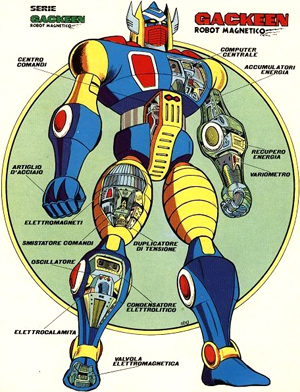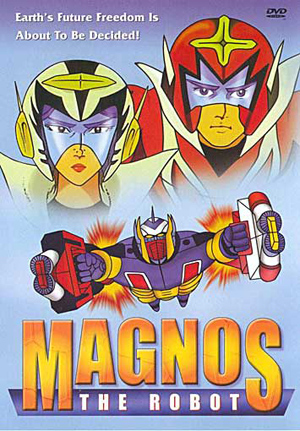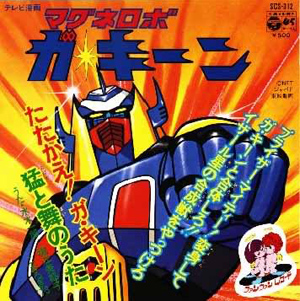
The Seventies were a simpler time, a time when being the undisputed martial arts champion of the world sometimes meant you had to karate chop a bull in the skull. It was a time when your whimsical walks on the beach were often interrupted by pink robots crashing into the surf and drilling things with the retractable drill guns they hide in their chest cavities, because that’s what pink robots do. And, hey, that bull was really asking for it.

I realize the preceding paragraph doesn’t make a great deal of sense. That’s okay. Neither did the Seventies, and neither did the animation produced in that time period, when a mind-boggling number of Japanese super robot shows were scrambling to sell toys to children. One of those shows was Magne Robo Gakeen, a Toei anime from 1976 that was repackaged in 1983 by International Media Group and Century Video and released to American audiences as Magnos the Robot. Today, Magnos the Robot is important because it represents the heights and depths of anime in a microcosm: it is at once wildly imaginative, crassly commercial, totally awesome, and totally lame.
In Magnos, the alien menace of the Paleo-Goths, awakened from their ancient slumber by environmental changes, threatens to destroy human civilization as we know it. Only Sir Miles Nevers, a mad scientist with a bodacious Abe Lincoln beard, and a sentai team of surly teenagers stands between the tyrannical Xerxes Tire-Iron Dada and total world domination. By harnessing the awesome power of complementary magnetic charges, Janus (the aforementioned bull-punching karate expert) and Lady Ester (the pilot of the pink robot) can combine to become the belt buckle of Magnos, an unstoppable scientific juggernaut capable of destroying the worst synthetic animals that the Paleo-Goths can muster. Whether it be the sinister, fire-breathing Batroacher III or the Lovecraftian horror that is Krustakos Primo (a half-crayfish, half-eel monstrosity), humanity shall prevail, because Magnos is equipped with the best super weapons that crazy mad scientists with unlimited resources and no design sense can provide.
It’s a pity that Sir Miles designed the Magnos robot with the sleek, delicate ankles of a ballet dancer. Who could have predicted that weak feet would be the giant robot’s Achilles heel?
Trust me, all this makes perfect sense in context…

I could tell you of so many wonders. I could sing you a tale of the Ft. Liberty, the mighty mobile battle fortress of the Magnos team, which combines the visual aesthetics of a summer squash with the aerodynamic qualities of a soup tureen. I could tell you of the minions of the Xerxes Tire-Iron Dada: Cipher, the robot-elephant man; Estroydia, the lady with the starfish helmet and the clamshell bikini; the broccoli-headed leader known as Brain. I could tell you of the ineffectiveness of the other three members of the sentai team—the fat guy, the skinny guy, and the shrimp—who charge into battle in unlikely, explosion-prone vehicles that are an ungainly fusion of helicopter and harrier jet. I could tell you that the transformations required to assemble and activate the Magnos super-robot are some of the most inefficient and stupefying that I’ve ever seen. I could mention that the bad guys blow up the Arc de Triomphe twice. But to do so would spoil the majesty and the mediocrity that is Magnos.
For Magnos is nothing if not magnificently mediocre. It was spawned by an age of Japanese giant robot animation in which studios scrambled to find the next hit thing with the kiddies and then repackage it, recycle it, or rip it off. And if the animation in question somehow managed to make it to American shores, it was only in altered, edited, bowdlerized fashion. Great pains were taken to strip Magnos of its Japanese-ness: they renamed characters, they covered up kanji with obnoxious gray video overlays, they attacked the source material with pruning shears until a thirty-nine-episode TV series became a ninety-minute TV movie fit for syndication. The younger generations of anime fans may not remember, but this is how anime was treated on the infrequent instances it was imported to the United States. Today we have simulcasts, streaming services, DVD and Blu-ray. But in 1983, before the Internet and the entire home video experience was a foregone conclusion, we had Magnos the Robot.
And I wouldn’t have it any other way. The five-year-old me would have loved Magnos, consuming it alongside such half-forgotten video treasures as Voltron: Fleet of Doom. The thirty-year-old me can view Magnos for what it is: extraordinarily typical, typically extraordinary, an artifact of obsolete business practices, as behind the times  as the Paleo-Goths and their hordes of synthetic animals. Purchased for three dollars at a Walgreens pharmacy alongside a Canadian bootleg of Elvira: Mistress of the Dark, this DVD managed to sit unopened on my shelves for eleven years; the licensor, Liberty International Publications, a company best known for its low-priced knockoffs of popular Disney titles, apparently no longer exists. Their website is an empty address, and Google searches only pull up results for insurance underwriters and trucking companies.
as the Paleo-Goths and their hordes of synthetic animals. Purchased for three dollars at a Walgreens pharmacy alongside a Canadian bootleg of Elvira: Mistress of the Dark, this DVD managed to sit unopened on my shelves for eleven years; the licensor, Liberty International Publications, a company best known for its low-priced knockoffs of popular Disney titles, apparently no longer exists. Their website is an empty address, and Google searches only pull up results for insurance underwriters and trucking companies.
Times change. The world moves on regardless. But Magnos—wonderful, stupid, hilarious Magnos—remains the same.
Distributor: Liberty International Publishing Inc.
Originally released: 1976
Running Time: 90 minutes


![SSSS.Dynazenon [Anime Review] SSSS.Dynazenon [Anime Review]](https://otakuusamagazine.com/wp-content/uploads/2021/08/16-9-SSSS.Dynazenon_Key_Visual_3.5-480x360.jpg)
![Back Arrow [Anime Review] Back Arrow [Anime Review]](https://otakuusamagazine.com/wp-content/uploads/2021/07/ba15-02686-480x360.jpg)



